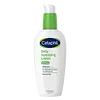What's inside
What's inside
 Key Ingredients
Key Ingredients

 Benefits
Benefits

 Concerns
Concerns

No concerns
 Ingredients Side-by-side
Ingredients Side-by-side

Water
Skin ConditioningDicaprylyl Carbonate
EmollientHydroxyethyl Urea
HumectantCyclopentasiloxane
EmollientGlycerin
HumectantGlyceryl Stearate
EmollientPEG-100 Stearate
Hydrolyzed Hyaluronic Acid
HumectantSodium Hydroxide
BufferingHomarine Hcl
Skin ConditioningSodium PCA
HumectantCetyl Alcohol
EmollientCaprylyl Glycol
EmollientPhenoxyethanol
PreservativeAcrylates/C10-30 Alkyl Acrylate Crosspolymer
Emulsion StabilisingErythritol
HumectantWater
Skin ConditioningAlcohol Denat.
AntimicrobialGlycerin
HumectantNeopentyl Glycol Diheptanoate
EmollientDicaprylyl Carbonate
EmollientHydroxypropyl Starch Phosphate
1,2-Hexanediol
Skin ConditioningBehenyl Alcohol
EmollientCetearyl Alcohol
EmollientCopernicia Cerifera Wax
Glyceryl Stearate
EmollientPropylheptyl Caprylate
EmollientTapioca Starch
Glycine Soja Germ Extract
EmollientGlycyrrhetinic Acid
Skin ConditioningSodium Hyaluronate
HumectantTocopherol
AntioxidantSodium Stearoyl Glutamate
CleansingPhenoxyethanol
PreservativeSilica Dimethyl Silylate
EmollientDisodium EDTA
Ethylhexylglycerin
Skin ConditioningXanthan Gum
EmulsifyingWater, Alcohol Denat., Glycerin, Neopentyl Glycol Diheptanoate, Dicaprylyl Carbonate, Hydroxypropyl Starch Phosphate, 1,2-Hexanediol, Behenyl Alcohol, Cetearyl Alcohol, Copernicia Cerifera Wax, Glyceryl Stearate, Propylheptyl Caprylate, Tapioca Starch, Glycine Soja Germ Extract, Glycyrrhetinic Acid, Sodium Hyaluronate, Tocopherol, Sodium Stearoyl Glutamate, Phenoxyethanol, Silica Dimethyl Silylate, Disodium EDTA, Ethylhexylglycerin, Xanthan Gum
 Reviews
Reviews

Ingredients Explained
These ingredients are found in both products.
Ingredients higher up in an ingredient list are typically present in a larger amount.
Dicaprylyl Carbonate comes from carbonic acid and caprylyl alcohol, a fatty alcohol. It is an emollient and gives skin a velvet feel. The sources of Dicaprylyl Carbonate may be synthetic or from animals.
As an emollient, Dicaprylyl Carbonate creates a film on the skin. This film traps moisture in, keeping your skin soft and hydrated.
Glycerin is already naturally found in your skin. It helps moisturize and protect your skin.
A study from 2016 found glycerin to be more effective as a humectant than AHAs and hyaluronic acid.
As a humectant, it helps the skin stay hydrated by pulling moisture to your skin. The low molecular weight of glycerin allows it to pull moisture into the deeper layers of your skin.
Hydrated skin improves your skin barrier; Your skin barrier helps protect against irritants and bacteria.
Glycerin has also been found to have antimicrobial and antiviral properties. Due to these properties, glycerin is often used in wound and burn treatments.
In cosmetics, glycerin is usually derived from plants such as soybean or palm. However, it can also be sourced from animals, such as tallow or animal fat.
This ingredient is organic, colorless, odorless, and non-toxic.
Glycerin is the name for this ingredient in American English. British English uses Glycerol/Glycerine.
Learn more about GlycerinGlyceryl Stearate is a mix of glycerin and stearic acid.
It is used to stabilize the mixing of water and oil ingredients. By preventing these ingredients from separating, it can help elongate shelf life. It can also help thicken the product's texture.
As an emollient, it helps soften skin and supports barrier-replenishing ingredients.
In cosmetics, Glyceryl Stearate is often made from vegetable oils or synthetically produced.
This ingredient may not be fungal-acne safe
Fun fact: The human body also creates Glyceryl Stearate naturally.
Learn more about Glyceryl StearatePhenoxyethanol is a preservative that has germicide, antimicrobial, and aromatic properties. Studies show that phenoxyethanol can prevent microbial growth. By itself, it has a scent that is similar to that of a rose.
It's often used in formulations along with Caprylyl Glycol to preserve the shelf life of products.
Water. It's the most common cosmetic ingredient of all. You'll usually see it at the top of ingredient lists, meaning that it makes up the largest part of the product.
So why is it so popular? Water most often acts as a solvent - this means that it helps dissolve other ingredients into the formulation.
You'll also recognize water as that liquid we all need to stay alive. If you see this, drink a glass of water. Stay hydrated!
Learn more about Water